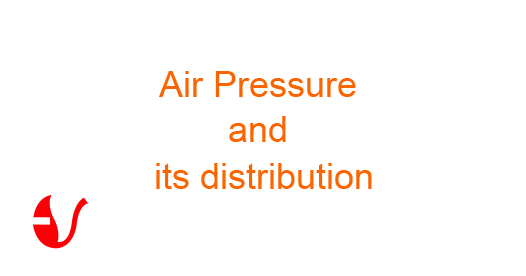
What is Air Pressure?
Air pressure is defined as total weight of a mass of column of air above per unit area at sea level.
• The atmospheric pressure is maximum at sea level. Average sea level pressure over the globe is about 1013mb.
• The line joining the places of equal pressure at sea level are called Isobars.
• Air pressure decreases with increasing altitude at the rate of 0.1 inch or 3.4 mb per 600 feet.
• The highest sea level pressure of 1075.2 mb was recorded at Irkutsk in Siberia on 14 January,1893 while the lowest sea level pressure of 877 mb was recorded in Marina Island.
• The gradual change of pressure between different areas is known as the Barometric slope or the Pressure Gradient.
PRESSURE TYPES
Air pressure is generally divided into two types.
High pressure
• High pressure systems are characterized by highest air pressure in the center of almost closed isobars where in pressure decreases from center outward and the lowest pressure is found at the outer margin of the high pressure system.
• This system is also called as Anticyclone.
• High pressure is indicative of dry weather condition.
• High pressure systems are caused both thermally (excessive cooling) and dynamically (subsidence of air from the above).
Low pressure
• Low pressure systems are also called Low or simply L or cyclones or depressions.
• These are centres of low pressure having increasing pressures outward and closed air circulation from outside towards the central low pressure in such a way that air blows inward in anti clockwise in the southern hemisphere.
• The heat lows or thermal lows generally develop during summer days due to intense heating of ground surface in the tropical and subtropical zone.
LATITUDINAL DISTRIBUTION OF PRESSURE
In all, there are seven pressure belts on the globe. On the basis of mode of genesis pressure belts are divided into two broad categories,
(1) thermally induced pressure belts (equatorial low pressure belt and polar high pressure belt) and (2) dynamically induced pressure belts (subtropical high pressure belt, sub polar low pressure belt).
Equatorial low pressure belt
• It is located either side of the geographical equator in a zone extending between 50N and 50 S latitudes.
• This zone is not stationary because there is seasonal shift of this belt with the northward (summer solstice) and southward (winter solstice) migration of the sun.
• It is thermally induced pressure belt. Because of vertical sun’s rays, the air in contact with the heated ground surface also gets warmed.
• It represents the zone of convergence of north-east and south-east trade winds.
• There are light, feeble and variable winds within this convergence belt.
• Because of frequent calm condition, this belt is called a belt of calm or Doldrum.
Subtropical high pressure belt
It extends between the latitudes of 250 350 in both the hemispheres.
• This belt owes its origin to the rotation of the earth and sinking and setting down of winds. Hence, it is dynamically induced pressure belt.
• This zone is characterized by anti-cyclonic conditions which cause atmospheric stability and aridity. This is one of the reasons for the presence of hot deserts of the world in the western parts of the continents in a zone extending between 250 - 350 in both the hemispheres.
• This zone of high pressure is called Horse Latitude.
• This zone of high pressure is not a continuous belt but is broken into a number of high pressure centres or cells.
Sub-polar Low pressure belt
It is located between 600 - 650 latitudes in both the hemispheres.
• This low pressure is dynamically produced. Here, the surface air spreads outward from this zone due to rotation of the earth and low pressure is caused.
• It is more developed and regular in the southern hemisphere while it is broken in the northern hemisphere because of over-dominance of water in the former.
Polar high pressure belt
• High pressure persists at poles throughout the year because of prevalence of very low temperature all the year round.
• In fact, both the factors thermal and dynamic operate at the poles.
This article is shared by Priyanka Duta. Priyanka is a Guest Lecturer of Geography at New Alipore College, Kolkata.

Join The Discussion